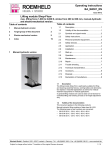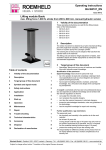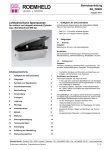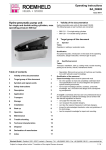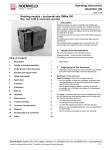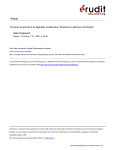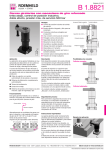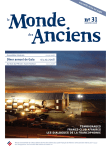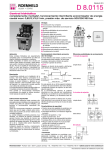Download Operating instructions BA M1101_EN Rotating module – horizontal
Transcript
Operating instructions BA M1101_EN Issue 09-12 Rotating module – horizontal axis DMH 200 Max. load 2,000 N, manual operation 1 1.1 Description General description The rotating module - horizontal axis DMH is a double supported rotation axis that can compensate high axial and radial forces. The angle of rotation in both directions is 360°. Due to special bearings it is insensitive to shocks and thrusts. The design of the rotating module allows its integration in applications with light as well as with heavy loads. When using the rotating module in assembly processes, workpieces can be rotated rationally, quickly and safely and can be assembled ergonomically from all sides. Except in its basic version, the rotating module is equipped with an indexing. The indexing angle is 8 x 45°, 6 x 60°; 4 x 90°; 3 x 120°. 1.2 Table of contents 1 Description 1 2 Validity of the documentation 2 3 Target group of this document 2 4 Symbols and signal words 2 5 Safety instructions 2 6 Application 3 7 Installation 3 8 Start up 6 9 Operation 6 10 Maintenance 8 11 Trouble shooting 10 12 Technical characteristics 10 13 Accessory 10 14 Disposal 10 15 Declaration of manufacture 11 Version without indexing The rotating module does not have an indexing in its basic version. The rotating operation is effected manually at the workpiece or at the assembly fixture. 1.3 Automatic indexing The rotating module with automatic indexing is a compact and functional unit. Rotating as well as indexing are ergonomically operated by one hand lever only. 1.4 Actively-operated indexing The rotating module - horizontal axis DMH 200 with actively operated indexing is a compact and functional unit. Rotating as well as indexing are ergonomically operated by one hand lever only. The rotating module with hydraulic indexing is a compact and functional unit. It consists of a basic module with integrated indexing mechanism and an operating unit with foot pedal, connected by a 2 m long hydraulic hose. This flexible connection allows the individual placement of the operating unit at the most favourable ergonomic position. The rotating operation is manually effected at the workpiece or at the assembly fixture. Römheld GmbH • Postfach 1253 • 35317 Laubach • Germany • Tel.: +49 (0)6405 / 89-0 • Fax: +49 (0)6405 / 89-211 • www.roemheld.de Subject to change without notice! Translation of the original German document 1 / 11 Operating instructions BA M1101_EN 2 Validity of the documentation Hazardous to the environment The symbol stands for important information for the proper handling with materials that are hazardous to the environment. Ignoring these notes can lead to heavy damages to the environment. This document applies to the following products: Rotating modules - horizontal axis of data sheet M 1.101. The following types or part numbers are concerned: • • • • Version without indexing Automatic indexing: Actively-operated indexing Indexing with foot pedal 6505-02-36-O 6505-01-36-M, 6505-02-36-M, 6508-02-45-O-I, Mandatory sign! The symbol stands for important information, necessary protection equipment, etc. 6508-02-60-O-I, Note This symbol stands for tips for users or especially useful information. This is no signal word for a dangerous or harmful situation. 6508-02-36-O-I, 6508-02-12-O-I. 3 • Target group of this document Specialists, fitters and set-up men of machines and installations with hydro-mechanical expert knowledge. Qualification of the personnel Expert knowledge means that the personnel must • be in the position to read and completely understand technical specifications such as circuit diagrams and productspecific drawing documents, • have expert knowledge of function and design of the corresponding components. A specialist is somebody who has due to its professional education and experiences sufficient knowledge and is familiar with the relevant regulations so that he • can judge the entrusted works, • can recognize the possible dangers, • can take the required measures to eliminate dangers, • knows the acknowledged standards, rules and guidelines of the technology. • has the required knowledge for repair and mounting. 5 Safety instructions 5.1 Basic information The operating instructions serve for information and avoidance of dangers when installing the products into the machine as well as information and references for transport, storage and maintenance. Only in strict compliance with these operating instructions, accidents and property damages can be avoided as well as trouble-free operation of the products can be guaranteed. Furthermore, the consideration of the operating instructions will result in: • reduced down times and repair costs, • increased service life of the products. Note These operating instructions are not a replacement for the operating instructions of the entire machine. 5.2 General safety tips WARNING 4 Symbols and signal words DANGER Danger of life / heavy health damages Stands for an imminent danger. If it is not avoided, death or very severe injuries will result. WARNING Person damage Stands for a possibly dangerous situation. If it is not avoided, death or very severe injuries will result. CAUTION Easy injuries / property damage Stands for a possibly dangerous situation. If it is not avoided, minor injuries or material damages will result. Injuries due to misuse, incorrect operation or abuse! Injuries can occur if the product is not used within the intended use and the technical performance data. Before start up, read the operating instructions! WARNING Poisoning due to contact with hydraulic oil! Wear, damage of the seals, ageing and incorrect mounting of the seal kit by the operator can lead to escapes of oil. Incorrect connection can lead to escapes of oil at the ports. For handling with hydraulic oil consider the material safety data sheet. Wear protection equipment. 2 / 11 Operating instructions BA M1101_EN WARNING 6.2 WARNING Injury by crushing! Components of the product make a movement while they are in operation. This can cause injuries. Keep parts of the body and items out of the working area! CAUTION Damage of components! Side loads and forced conditions on the product lead to the premature failure. Avoid forced conditions (overdetermination) of the product. Max. forces and torques see technical characteristics. CAUTION Damage of components! The admissible performance data of the product, see chapter "Technical characteristics", may not be exceeded. Note - qualification of the user All works may only be effected by qualified personnel familiar with the handling of hydraulic components. 5.3 Personal protective equipment For works at and with the product, wear safety goggles! For works at and with the product, wear protective gloves! For works at and with the product, wear safety shoes! 6 Application 6.1 Intended use Rotating modules are designed for universal use in assembly and handling processes in the industry. They are used for industrial applications in order to rotate workpieces rationally, quickly and safely. Furthermore the following are possible uses: • Max. forces and / or torques only with the values indicated below technical characteristics. • Max. torques at the hand lever only with the values indicated below technical characteristics. • Use only within closed, low-dust rooms • Use within the capacity indicated in the technical characteristics (see data sheet). • Use as per operating instructions. • Compliance with service intervals. • Qualified and trained personnel for the corresponding activities. • Mounting of spare parts only with the same specifications as the original part. Misapplication Injuries, material damages or malfunctions! The product must never be opened. At the product no changes must be made, except the ones expressly mentioned in the operating instructions! The use of these products is not admitted: • For domestic use. • On pallets or machine tool tables in primary shaping and metal forming machine tools. • If due to vibrations or other physical / chemical effects damages of the products or seals can be caused. • On pallets or machine tool tables that are used to change the characteristics of the material (magnetise, radiation, photochemical procedures, etc.). • In areas for which special guidelines apply, especially installations and machines: - For the use on fun fairs and in leisure parks. - In food processing or special hygiene regulations. - For military purposes. - In mines. - In explosive and aggressive environments (e.g. ATEX). - In medical engineering. - In the aerospace industry. - For passenger transport. 7 7.1 Installation Design WARNING Injury by falling parts! Keep hands and other parts of the body out of the working area. Wear personal protection equipment! CAUTION Damage of components! Some product types have a considerable weight. These have to be secured against working free during transport. Weight specifications see chapter "Technical characteristics". CAUTION Damage of components! Side loads and forced conditions on the product lead to the premature failure. Avoid forced conditions (overdetermination) of the product. Max. forces and torques see technical characteristics. 3 / 11 Operating instructions BA M1101_EN CAUTION CAUTION Damage of components! The maximum operating torque at the operating shaft must not be exceeded. This can be achieved e.g. by limiting the operating stroke of the customer's operating element (hand lever or pedal) by the floor. 7.2 Version without indexing Damage of components! Foot pedal is pressed down below the lower edge of the base plate. The customer has to make sure that this will be prevented by the concrete floor or a corresponding base plate connecting construction. 7.5 Version with hydraulic indexing The rotating module does not have an indexing in its basic version. The rotating operation is effected manually at the workpiece or at the assembly fixture. 7.3 Version with automatic indexing Figure 1: Components a Basic unit b Flange plate c1 Threads (4 x M10) to fix further components c2 Counterbores (for 4 x M10) to fix the rotary module at the fixture 7.4 c4 Threads (4 x M10) to fix further components vertically on the fixture d Hand lever e Button for unlocking Figure 3: Components Version with actively-operated indexing CAUTION Damage of components! Foot pedal is pressed down below the lower edge of the base plate. The customer has to make sure that this will be prevented by the concrete floor or a corresponding base plate connecting construction. Figure 2: Components a Basic unit b Flange plate c1 Threads (4 x M10) to fix further components c2 Counterbores (for 4 x M10) to fix the rotary module at the fixture c4 Threads (4 x M10) to fix further components vertically on the fixture d Hand lever 4 / 11 Operating instructions BA M1101_EN 4. For this purpose professionally insert into the concrete floor heavy-duty dowels (e.g. Fischer part-no.: SL M-10 N). Figure 4: External stop a Basic unit b Flange plate c1 Threads 4 x M10 to fix further components c2 Counterbores for 4 x M10 to fix the rotary module at the fixture c1 Threads 4 x M10 to fix the index. Not suitable to fix add-ons. c4 Threads 4 x M10 to fix the rotating module vertically on the fixture d e f g 1 Hydraulic indexing (receiver unit) Foot pedal Pressure generator (transmitter unit) Bore holes 4 x M8 to fix the pressure generator External stop Note Pressure generators, hoses and hydraulic indexing must not be opened. Penetrating air can lead to malfunction. 7.6 Fixing of the product WARNING Injury due to overturning product! Overturning product due to missing or incorrect fixing! Fasten bottom plate on the floor. When introducing torques within the load limit (see technical characteristics) we recommend to use an additional base plate (accessory) and to secure this plate correctly. CAUTION Figure 5: Possible principles of fixation. 1 2 Fixation for vertical mounting screwed through customer's fixture if required through flange plate (see accessories) of pressure generator (transmitter unit) 3 4 Wall mounting screwed through rotary module Angle bracket provided by the customer at the flange plate Not admissible! Note In case of vertical mounting of the rotating module it has to be considered that the hand lever can only be rotated by 270°. Note To reach the third indexing position a swing angle of ~230° is required. Note The mounting types depend on the design of the rotating module. Damage of components! Foot pedal is pressed down below the lower edge of the base plate. The customer has to make sure that this will be prevented by the concrete floor or a corresponding base plate connecting construction. 1. Install the product so that for the required cleaning and maintenance works there is all around a clearance zone of at least 700 mm. 2. The product has to be mounted horizontally on a plane and solid concrete floor (concrete strength grade B 25) or a rigid connecting construction of the customer (flatness 0.20 mm). 3. Fasten the bottom plate of the product with hexagon socket head cap screws ISO 4762 - M10 onto the concrete floor or the connecting construction of the customer. 5 / 11 Operating instructions BA M1101_EN 7.7 Mounting of the customer's connecting construction WARNING Injury due to overturning product! Overturning product due to eccentric load provided by the user! The centre of gravity of the user's load must be within the 4 fixing screws of the bottom plate. When introducing torques within the load limit (see technical characteristics) we recommend to use an additional base plate (accessory) and to secure this plate correctly. - Pay attention to collision-free motion with regard to surrounding equipment. - Pay attention to ergonomic working conditions. - Pay attention to maximum and admissible physical forces. 3. Check movement and resulting loads. Carefully rotate the mounted construction and the workpiece. - Carry out tests as listed below 2. 4. Check the functions of the rotary module. Pay attention to smooth running. 9 WARNING 1. For fixing of the customer's connecting construction there are 4 bore holes (for M10 - ∅ 10.5 mm ) at the top plate. All provided bore holes have to be used! 2. Fasten the connecting construction at the top plate. Injury by crushing! Loads (torques) can lead to an unexpected start of the product. When releasing the index, counter hold the existing load. Pay attention to an ergonomic working place and max. physical forces. Note Dangers due to the connecting construction of the customer, as e.g. squeezing points have to be excluded by the customer's design. WARNING Injury by crushing! Components of the product make a movement while they are in operation. This can cause injuries. Keep parts of the body and items out of the working area! In the case of eccentric loads, it is recommended to compensate these by counterweights. This prevents unregulated swinging of the load (changing - swivelling). In off-position the indicated maximum torques may occur (see Technical characteristics). The required forces and torques, around the axis of rotation, have to be considered by the operator. During the rotating motion only 50% of the maximum values are admitted. CAUTION Damage of the indexing! If the indexing bolt engages in full motion, the indexing will be dynamically overloaded. The module must only be moved to the engaging position in a controlled manner (counterhold). The max. force of 50 N (rotation or holding) must not be exceeded by the operator. 8 Operation Start up WARNING Injury by crushing! Loads (torques) can lead to an unexpected start of the product. When releasing the index, counter hold the existing load. Pay attention to an ergonomic working place and max. physical forces. 9.1 Version without indexing The rotating module does not have an indexing in its basic version. The rotating operation is effected manually at the workpiece or at the assembly fixture. WARNING Injury by crushing! Due to protruding components there can be pinch points during installation. Keep hands and fingers away from pinch points! The following tests have to be carried out before start up: 1. Check tight seat (check seating torque of the fixing screws). 2. Check the freedom of motion of the existing loads. Rotate the rotating modules with mounted customer's fixture 4 x 90°. - Pay attention to shearing and squeezing points. Mount a protective guard, if required. 6 / 11 Operating instructions BA M1101_EN 9.2 Automatic indexing 9.3 Version with actively-operated indexing CAUTION Load swings unexpectedly! This can lead to injuries or damages. During swinging under load the unlocking must not be actuated. Figure 7: Operation - Actively-operated indexing Figure 6: Operation - Automatic indexing 1 Operation of the hand lever 2 Unlocking of the hand lever To rotate the workpiece the hand lever is operated in any direction (1). Every 90° indexing of the position is made automatically. Engagement and disengagement of the indexing is also effected automatically. The off-position of the hand lever can be engaged in steps of 90°, so that for every rotation the desired off-position can be adjusted. 1 Unlocking of the load 2 Operation of the hand lever To unlock the indexing position the hand lever has to be tilted in axial direction by approx. 10° (1) to get connected by form fit with the rotating module. The workpiece can now be rotated in any direction (2) by means of the hand lever. Only after safe locking in the desired position, by tilting back the lever, the hand lever is free again and the workpiece locked with the housing by form fit. The off-position of the hand lever can be engaged in steps of 90°, so that for every rotation the desired off-position can be adjusted. With engaged indexing the button for unlocking (2) can be pushed and the lever freely swivelled. To engage the indexing, release the button. 7 / 11 Operating instructions BA M1101_EN 9.4 Hydraulic indexing 10.3 Monthly checks • Visual inspection. • Check the unit for damages and possible running marks, repair if required. • Check the axial and radial clearance, repair if required. • Check the indexing for smooth running and clearance Note Repair works, as e.g. the change of the interior lifting jack may only be effected by the ROEMHELD service technicians. 10.4 Yearly checks Hydraulic system, hydraulic hoses An expert has to check all hydraulic components at least once a year if they are still work-proof. Assessed damages have to be repaired immediately. # Figure 8: Operation - Indexing operated by a foot pedal By operating the foot pedal by 35° the index is released and the workpiece or the fixture can be rotated. If the foot pedal is not operated, the index bolt engages automatically into the next indexing position. The operation with a foot pedal guarantees that the operator always has both hands free. The following checks and works have to be effected: • An expert has to check all hydraulic hoses at least once a year if they are still work-proof. Assessed damages have to be repaired immediately. • The hydraulic hoses of the device have to be exchanged as per BGR 237 at least after 6 years by new ones. 10 Maintenance 10.1 Plan for maintenance Maintenance works Interval Cleaning, visual check of daily the rotating module and control of the indexing Check all fixing screws, half-yearly retighten if required. checks Control of the indexing Check smooth running with yearly little load over the entire rotating range Check smooth running with yearly load over the entire rotating range Revision by the manufacAfter 50,000 turer (recommendation) cycles Repair in case of damages 10.5 by... Operator Repair Note Repair works, as e.g. the change of the interior lifting jack may only be effected by the ROEMHELD service technicians. Expert Expert Expert ROEMHELD service staff ROEMHELD service staff Note Pay attention to the qualification of the personnel. 10.6 Maintenance of the hydraulic indexing The rotating module with hydraulic indexing is a compact and functional unit. It consists of a basic module with integrated indexing mechanism and an operating unit with foot pedal, connected by a 2 m long hydraulic hose. This flexible connection allows the individual placement of the operating unit at the most favourable ergonomic position. The rotating operation is manually effected at the workpiece or at the assembly fixture. The design of the indexing is a closed system. When opening the system, the preloaded effect will get lost. To guarantee a system free from air, the transmitter unit, the high-pressure hose and the receiver unit must be flushed. 10.2 Cleaning The following cleaning works have to be effected daily at the mechanical components. 1. Clean with cleaning clothes or cleaning rags. 2. Slightly lubricate the metallic components (plates, guides, etc.). 8 / 11 Operating instructions BA M1101_EN Procedure: Note Align the transmitter unit as shown in the figure. Oil must be in the connecting port up to the upper edge of the connecting thread. Refill oil, if required. Put the plug slightly tilted onto the surface of the oil and screw in. 5. Vent the receiver unit CAUTION Injury due to the spring in the subassembly! The component can slip and the the piston extends. Provide a holding device! Figure 9: Sketch how to vent the indexing 1 2 3 Direction of flushing Transmitter unit Receiver unit High-pressure hose 2 m 4 5 6 Pressure generator for flushing, with return line to the reservoir Flushing line Reservoir line 1. Connection of hose lines (see fig. of the sketch). Note The ports have to be aligned towards the top. 2. Connect to a pressure generator (preferably to a small power unit). 3. Flush the system several minutes. Actuate the pedal several times to loosen trapped air bubbles. Figure 11: Alignment for bubble free mounting of the fittings 3 6 8 High-pressure hose 2 m Reservoir line Vice or clamp F Force required S Stroke approx. 13.5 mm Receiver unit in shown alignment, in the vice, preload and remove reservoir line. Note Align the receiver unit as shown in the figure. Oil must be in the connecting port up to the upper edge of the connecting thread. Refill oil, if required. Figure 10: Alignment for bubble free mounting of the fittings Pay attention to the oil level 7 Plug Put the plug slightly tilted onto the surface of the oil and screw in. 6. Loosen the preload of the receiver unit. 7. Check function. 4. Align the transmitter unit as shown and remove the flushing line. 9 / 11 Operating instructions BA M1101_EN 11 Trouble shooting CAUTION Damage of components! All works only to be effected by ROEMHELD service staff. All rotating modules Trouble Cause Indexing does not Too fast rotation engage Max. admissible torques exceeded Indexing defect Top plate lowers without operation of the foot pedal Internal lifting jack defect Clearance in the indexing too large Wear or max. admissible torques exceeded Only for indexing with foot pedal Trouble Cause Indexing does not Air in the hydraulic disengage system Components were opened Remedy Decelerate rotation Caution ! Works only to be effected by ROEMHELD service personnel. Replace the lifting jack by ROEMHELD service personnel Caution ! Works only to be effected by ROEMHELD service personnel. Remedy Caution ! Works only to be effected by ROEMHELD service personnel. 12 Technical characteristics Lifti ng force (F) Maximum admissible load Max. admissible forces, for all versions Fx = ± 2,000 N Fy = ± 2,000 N Fz = ± 1,000 N. Max. admissible torques Note These torques are valid for all versions with indexing in engaged mode. In the case of eccentric loads, it is recommended to compensate these by counterweights. In off-position the indicated maximum torques may occur. General characteristics Type 6505 02 36 O Without indexing 6505 01 36 M 6505 02 36 M 6508 02 XX O I Automatic indexing Actively-operated indexing Indexing with foot pedal Weight (dead weight) Type 6505 02 36 O Without indexing 6505 01 36 M Automatic indexing 6505 02 36 M Actively-operated indexing 6508 02 XX O I Indexing with foot pedal Mz [Nm] not relevant 250 500 800 m [kg] 14 19 19 25 Note For further technical data see data sheet. 13 Accessory Note See data sheet. 14 Disposal Hazardous to the environment Due to possible environmental pollution, the individual components must be disposed only by an authorised expert company. The individual materials have to be disposed as per the existing regulations and directives as well as the environmental conditions. Special attention has to be drawn to the disposal of components with residual portions of hydraulic fluids. The instructions for the disposal at the material safety data sheet have to be considered. For the disposal of electrical and electronic components (e.g. stroke measuring systems, proximity switches, etc.) countryspecific legal regulations and specifications have to be kept. Figure 12: Axes of the introduced forces and torques M Max. torques in the axes: X, Y or Z F Max. admissible forces in the axes: X, Y or Z 10 / 11 Operating instructions BA M1101_EN 15 Declaration of manufacture Manufacturer Römheld GmbH Friedrichshütte Römheldstraße 1-5 35321 Laubach, Germany Tel.: +49 (0) 64 05 / 89-0 Fax: +49 (0) 64 05 / 89-211 E-mail: [email protected] www.roemheld.com Responsible person for the documentation: Dipl.-Ing. (FH) Jürgen Niesner, Tel.: +49(0)6405 89-0. 15.1 Validity of the documentation This document applies to the following products: Rotating modules - horizontal axis of data sheet M 1.101. The following types or part numbers are concerned: • • • • Version without indexing Automatic indexing: Actively-operated indexing Indexing with foot pedal DIN EN 1037, 2008-11, safety of machinery - prevention of unexpected start-up. DIN EN 81714-2, 2007-08, Design of graphical symbols for use in the technical documentation of products Römheld GmbH Friedrichshütte Laubach, 10.09.2012 6505-02-36-O 6505-01-36-M, 6505-02-36-M, 6508-02-45-O-I, 6508-02-60-O-I, 6508-02-36-O-I, 6508-02-12-O-I. 15.2 List of the applied standards 2001/95/EC, General product safety 92/58/EEC, Minimum requirements for the provision of safety and/or health signs at work 89/391/EEC, Introduction of measures to encourage improvements in the safety and health of workers at work CE 89/655/EEC, Minimum safety and health requirements for the use by workers of personal protective equipment at the workplace Operating safety regulations (BetrSichV) for the transposal of the directive on the introduction of measures to encourage improvements in the safety and health of workers at work. (German implementation of the Work Equipment Directive 89/655/EEC) Product Safety Act - PSG; November 2011 DIN EN ISO 12100, 2011-03, Safety of machinery; Basic concepts, General principles for design (replacement for part 1 and 2) DIN EN ISO 13857; 2008-06, Safety of machinery - Safety distances to prevent hazard zones being reached by upper and lower limbs. (replaces: DIN EN 294) DIN EN 349, 2008-09, Safety of machinery. Minimum gaps to avoid crushing of parts of the human body DIN EN 614-1 a. 2, 2009-06, Safety of machinery - Ergonomic design principles DIN EN 1494; 2009-05, Mobile or movable jacks and associated lifting equipment DIN EN 626-1, 2008-09, Safety of machinery - Reduction of risks to health from hazardous substances emitted by machinery DIN EN ISO 4413, 2011-04, Hydraulic fluid power - General rules and safety requirements for systems and their components 11 / 11











